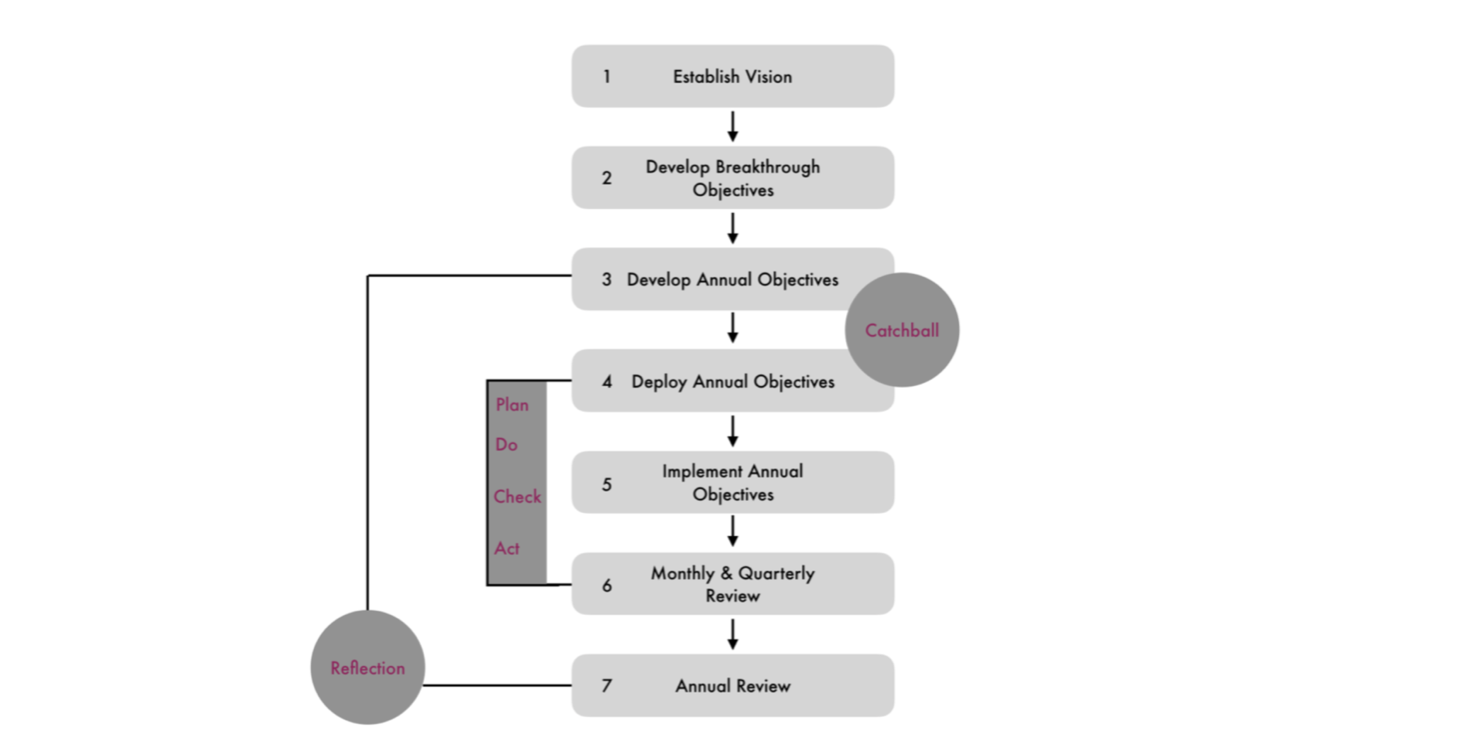
What is Hoshin Kanri?
The hoshin kanri methodology employs a structured planning and deployment cycle during which goals are determined, plans to achieve the goals are established, and measures are created to ensure progress toward these goals. Hoshin Kanri is a process that organizations use to develop their long-term strategy into concrete plans, and then execute that strategy over time. This planning process is designed to ensure that the mission, vision, goals, and annual objectives are communicated throughout an organization, and implemented by everyone from top management to the shop floor level. In this strategic planning process, the organization develops multiple vision statements to encourage breakthrough thinking about its future direction. Then goals and work plans are developed, based on the collectively chosen vision statement; and progress towards them is periodically monitored through performance audits. This is also called hoshin planning or policy deployment. It is a strategic business planning method to achieve break-through improvements through goal alignment and visual communication.
Hoshin Kanri is a Japanese phrase and word meaning is given below:
Hoshin = Shining needle pointing direction, as in compass
Kanri = Control or Management
Key proponents / practitioners of Hoshin Kanri include:

Where did Hoshin Kanri originate?
Hoshin Kanri arose out of the Lean movement in Japan in the 1950/60s and was quickly adopted by companies in both Japan and the United States. It has been adopted by many companies since then, sometimes under different names, such as Hoshin Planning or Goal / Policy Deployment. The most sophisticated companies using Hoshin Kanri have built it into a full Business System, encompassing Hoshin Kanri and Continuous Improvement principles to manage their businesses.
Why haven’t I heard much about it?
You may wonder why you haven’t heard about it much. One reason is that companies don’t always call it Hoshin Kanri - they tend to change the terminology to fit their organization. A more interesting reason is that many companies see it as their ‘secret sauce’ that drives their competitive advantage over the long term, and thus won’t share it widely.
So, what makes Hoshin Kanri special?
Hoshin Kanri is one of many methodologies derived from Peter Drucker’s Management by Objectives (MBO). These varying methodologies include:
• OKRs (Objectives and Key Results) which is popular in tech circles
• OGSM (Objectives, Goals, Strategies and Metrics) which is popular in retail, leisure and entertainment
• Hoshin Kanri, which is popular in manufacturing and in large conglomerates, where both central coordination and unit autonomy are prized
Why choose Hoshin Kanri?
Hoshin Kanri is recognized as the most structured of the MBO methodologies, and has several characteristics which make it unique. HK requires planning in multiple timeframes, from long-term to immediate actions, with direct links between each timeframe. While also enabling coordinated planning across organizational boundaries. Planning is both top-down and bottom-up, building both company-wide and individual commitment to the plans. Overall, HK requires measurement of success using both lagging and leading metrics. Where difficulties arise in meeting targets, HK provides a framework for resolving them.
What are the seven steps of Hoshin Kanri?
Further explained -> 7 Steps in Hoshin Kanri Planning Process

Is Hoshin Kanri appropriate for my organization?
Hoshin Kanri principles and methodology can be applied in any organization, in any sector, at any level.Teams, plants and divisions have enjoyed success using it separately from the wider organization they are part of, and large multinationals which have used it across the whole organization. It is important, however, to understand what your organization is capable of right now and introduce elements of Hoshin according to your immediate needs first.
4 common “ifs”
1. If your biggest pain point is focus, using Hoshin Kanri (HK) to narrow down your strategic choices is a great starting point.
2. If your organization is poor at setting measurable targets, HK provides a framework to develop these.
3. If you are struggling to create alignment around a plan of action, the HK catch-ball process may be the best place to start. Bringing teams together for short sharp workshops around Breakthrough or Annual Objectives can create motivation and momentum to overcome resistance.
4. If you have a good plan but your team loses focus after launch, the Plan-Do-CheckAct review process is a good way to change the culture around execution. No organization can change the entire way they plan and execute their strategy overnight. And any change encounters resistance. The lesson is to pick your battles wisely, deliver some quick wins, and then connect the dots afterwards.
What are the common hurdles to overcome when
implementing Hoshin Kanri?
Hoshin Kanri is a process to align the direction, alignment and communication for your organization. This requires a change in behavior for your organization’s people, processes and culture. Execution, and goal deployment in particular, is a specific set of behaviors, methodologies and tools that companies must master in order to gain, maintain and sustain competitive advantage.
Common barriers include:
1. Resistance to accountability: At any level of an organization you might find a senior executive, middle manager or team member who is resistant to hard and fast targets. Senior sponsorship is vital to overcoming opposition.
2. Process and commitment conflicts: Budgeting, senior leadership meetings and company-wide conferences are all interfaces with the Hoshin Kanri planning and execution cycle. Taking the time to ‘make it fit’ will alleviate unnecessary conflicts.
3. Fear of failure: In Hoshin, it is considered a learning opportunity – unmet targets need countermeasures, not criticism. It takes considerable senior leadership to build a culture of trust in an organization that is rife with fear of failure.
4. Inconsistent, incorrect data: Targets need to be measured against clean, real-time data in your organization sourced from multiple systems, and progress needs to be measured in a clear, consistent way. Organizations with Program / Project Management Offices or Continuous Improvement Centers of Excellence may already have clean data sources and standards in place, but for those that do not, building this capability is paramount.

📘Read More...
The 7 Steps in the Hoshin Kanri Planning Process
Rolling out HoshinCloud at scale for your organization

